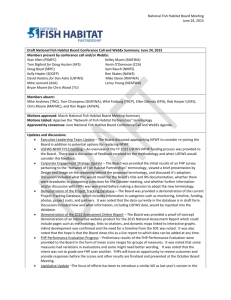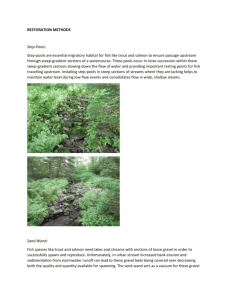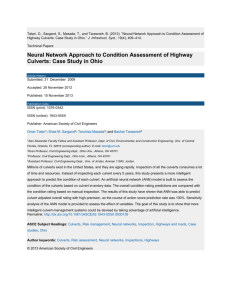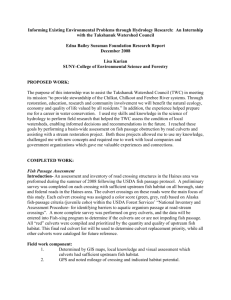Minutes, April 2013 - Tualatin River Watershed Council
advertisement
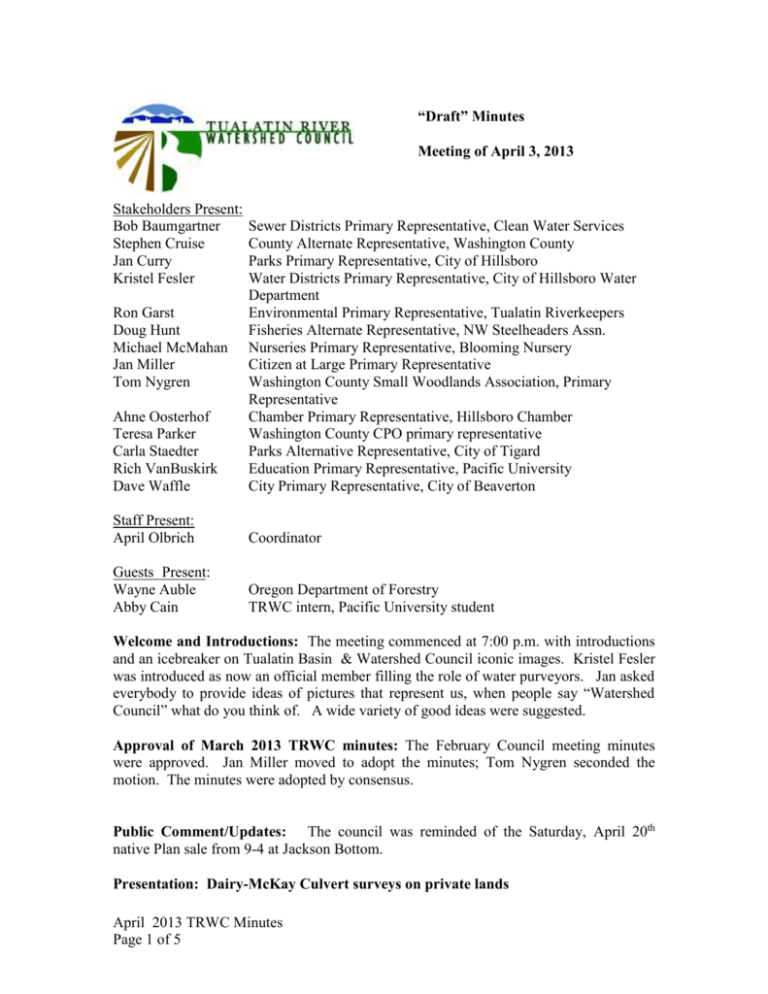
“Draft” Minutes Meeting of April 3, 2013 Stakeholders Present: Bob Baumgartner Stephen Cruise Jan Curry Kristel Fesler Ahne Oosterhof Teresa Parker Carla Staedter Rich VanBuskirk Dave Waffle Sewer Districts Primary Representative, Clean Water Services County Alternate Representative, Washington County Parks Primary Representative, City of Hillsboro Water Districts Primary Representative, City of Hillsboro Water Department Environmental Primary Representative, Tualatin Riverkeepers Fisheries Alternate Representative, NW Steelheaders Assn. Nurseries Primary Representative, Blooming Nursery Citizen at Large Primary Representative Washington County Small Woodlands Association, Primary Representative Chamber Primary Representative, Hillsboro Chamber Washington County CPO primary representative Parks Alternative Representative, City of Tigard Education Primary Representative, Pacific University City Primary Representative, City of Beaverton Staff Present: April Olbrich Coordinator Guests Present: Wayne Auble Abby Cain Oregon Department of Forestry TRWC intern, Pacific University student Ron Garst Doug Hunt Michael McMahan Jan Miller Tom Nygren Welcome and Introductions: The meeting commenced at 7:00 p.m. with introductions and an icebreaker on Tualatin Basin & Watershed Council iconic images. Kristel Fesler was introduced as now an official member filling the role of water purveyors. Jan asked everybody to provide ideas of pictures that represent us, when people say “Watershed Council” what do you think of. A wide variety of good ideas were suggested. Approval of March 2013 TRWC minutes: The February Council meeting minutes were approved. Jan Miller moved to adopt the minutes; Tom Nygren seconded the motion. The minutes were adopted by consensus. Public Comment/Updates: The council was reminded of the Saturday, April 20th native Plan sale from 9-4 at Jackson Bottom. Presentation: Dairy-McKay Culvert surveys on private lands April 2013 TRWC Minutes Page 1 of 5 April provided background for the presentation. About 1 – 11/2 years ago the council applied for a grant from the Bureau of Land Management (BLM), Stephen helped with the grant and training, Rich V., helped move the grant along and provided guidance. The county has done work to identify fish passage barriers associated with county roads, this project was a related effort to look at fish passage barriers on private roads. Rich V., introduced Abby Cain, a senior Environmental Biology Major, presenting her Senior Cap Stone Project. Abby noted that she segued her summer job into her Cap Stone project. Abby noted that there has been a lot of work done on defining important habitat; however, culverts can block access to that habitat. The work she did was a cooperative effort with BLM and Washington County addressing fish passage at culverts. The BLM is looking to develop a statewide inventory on culverts that may block access to their lands, similarly, the County is looking to prioritize work on, or replacement of culverts where it may help fish access habitat. Abby focused on private lands, which she noted covered 231 mi2, or about 85% of the land in the basin compared to 5% BLM with small state and county holdings. Abby noted that lots of culverts inhibit fish movement or block access, and if the impediment is removed, it can open habitat. Anadromous fish can be greatly affected. Abby noted different fish can be important for different reasons, examples included: Winter Steelhead are threatened Cutthroat Trout, relatively weak swimmers compared to other migratory salmon Coho, an important sport fish The methods used were presented including the use of LiDAR to identify potential blockage, paired with aerial photographs to matchup up with roads. Where blockage or sudden changes in stream topography was indicated which was associated with a road, it may be a culvert. In forested areas it is often difficult to see roads in aerial photographs; also the method does not describe flow, seasonal flows or volumes which may influence the quality or importance of habitat. Initially, the screening methods resulted in quite a few sites being misidentified. The original estimate was about 1073 identified culverts, 63 of which were unlikely to be a problem (leaving 1021). Out of this population of culverts 178 high priority sites were selected, based on proximity to essential habitat as identified by the Oregon Department of Fish and Wildlife (ODFW). They then contacted over 70 land owners receiving permission for 13 sites. Surveys of the culverts and qualitative habitat surveys were conducted for the 13 sites. Example slides were provided showing 2 culverts, 1 perched which created a jump which would be difficult to get fish above, and one culvert where stream pooling showed the culvert was about ½ blocked which would likely impede migration. They did severity rankings on 4 culverts that appeared to create blockage. The ranking method had been developed by Washington County and incorporated 4 factors, severity of the blockage, proximity to essential salmon habitat, habitat quality and habitat area. Scores ranged April 2013 TRWC Minutes Page 2 of 5 from 1 -13, with 13 indicating blockage of good upstream habitat. The scores were then compared to those previous priorities identified by Washington County. Washington County has a prioritized list of 20 sites, which now contains two (2) of the sites from this study The presentation generated a substantial amount of interest, questions and discussions. The bullet points below attempt to capture the following discussion and response to question: These are just some of the 1000’s of culvert sites out there, there are likely many more that would rank as high priority sites The size of the potential problem is not really known and difficult to extrapolate from the current data, more groundwork is needed There is still some funding from BLM, hopefully we can do more surveys The focus was on potential upstream habitat, it is reasonable to assume there are other barriers Out in the field it can be really surprising and interesting the things people do to put culverts in when they want to move water Need to do more than just restoration, need to remove barriers so that fish can get to restored sites, some think should first barriers should be removed first Council Discussion: Senator Merkley Letter The Council then moved to a discussion of the Senator Merkley letter regarding continued Pacific Coast Habitat funding which currently provides about $13-$14 million to Oregon. Following the discussion, which noted the draft letter routed to the council looked pretty good, the council unanimously voted to approve the letter. Council Discussion: Capacity Building Strategy April introduced the discussion by reminding us of the directive from OWEB that councils should diversify their base of funding. April noted that the steering committee has been brainstorming on how to build capacity. April turned the discussion over to Tom N., who walked us through a handout he had prepared for this discussion Tom noted that we should be looking at several aspects of diversification and thinking of resources, sweat equity, as well as cash. Tom laid out ideas that may be helpful for the watershed council and walked us through the handout. Some of the discussion points included We need more than an event, perhaps we should step back to look at the bigger picture We should look to our mission and if we have the capacity to meet our goals Can we identify our needs, and do we have the staff capacity to achieve those needs How can we increase participation by partners How do we develop a strategy? April 2013 TRWC Minutes Page 3 of 5 Tom N., lead the group through a discussion of what a strategy could be. A three point strategy was outlined: 1. The strategy should define the needs of the watershed and the council 2. Identify opportunities, examples included grants, agencies with similar goals, understanding of forum and function, how to overlap agencies goals and find common interest and funding base, education was cited as a broad goal with extensive common interest. 3. Develop and participate in venues to bring opportunities into maturity Tom noted that getting started was the key, and pointed to the last two (2) points (A and B) and observed that there was nothing there, need to get started (A) and then develop the business plan (B). Jan Curry noted that she (and Jackson Bottom) have experience as a volunteer coordinator and we could work to get volunteers involved. Jan noted that if we can harness the energy of young people that would be helpful, to get them involved. To do so we would need coordination, and good planning. The discussion agreed that volunteer outreach would provide one way to the council more visibility. Jan C., provided examples with teachers and service learning credits. Dave noted that Portland State University (PSU) has a program tract for non profit programs, we could get their help to find a champion Cap Stone student to develop a business model. A student may be interested and very helpful with the outreach, letters, and details associated with fund raising. Carla described a project that she would be interested in championing. Carla noted a highly urbanized creek would benefit from Christmas trees project and that she felt the project could be coordinated with the Council. Carla observed that she has had positive encouragement from Trout Unlimited and believed there would be others willing to participate. Carla reviewed the potential project as getting a student in marketing, engineering, somebody who could do the survey work to provide the basis for demonstrating the benefit of placing Christmas trees in the stream channel. Carla felt the project would provide good partnering and exposure opportunities, and perhaps be the basis for a couple master’s thesis. Kristel, noted she has an PSU student as an intern to do marketing in partial fulfillment of a masters thesis, (200 hours) Kristel, Jan, and Bob noted that they believe opportunity exist to reaching out to the business community and industries in the basin. Ducks Unlimited was also identified as a potential partner Tom N., noted that he was pleased with the conversation and identified 3 points: April 2013 TRWC Minutes Page 4 of 5 1. We need to continue to talk about our goals, what are the key things we as a Council want to achieve 2. How are we going to do the diversification, there has to be mutual benefit and we need to understand what our partners would get out of interaction with the Council 3. Marketing, how do people know about us, and what do we want them to know about us Continued discussion by the steering committee following Tom N’s., three points is warranted. Coordinator Update: Upcoming Volunteer opportunities: April 13, 10 am – 1 pm, Washington County Historical Museum, Free Family Earth Day activities; TRWC will be there April 20, 9 am – Noon, SOLVE-TRWC workday at Rippling Waters Stakeholder Updates: April 20, Jackson Bottom Wetlands Preserve Native Plant Sale, 9 am – 3 pm, April 20, 9 am – noon, SOLVE Derry Dell planting through City of Tigard April 23, 7 – 9 pm WCSWA mtg with ODF Forest Grove office District Forester The meeting adjourned at 9:00 p.m. Respectfully submitted, Bob Baumgartner Co-Secretary Refreshments for May 1 meeting: Carla Staedter Roving Steering Committee member for April 18: Kerry Nussbaumer Roving Steering Committee member for May 16: Carla Staedter April 2013 TRWC Minutes Page 5 of 5

